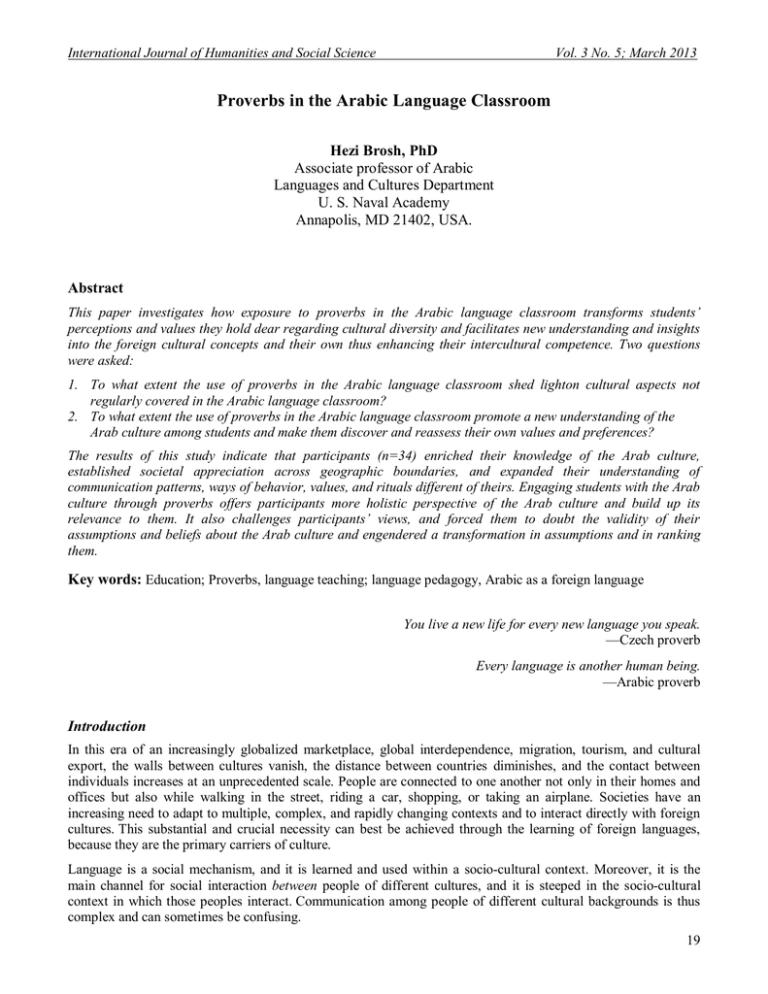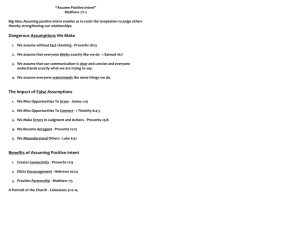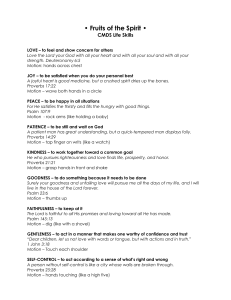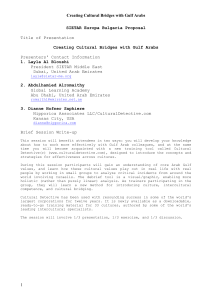Document 10454250
advertisement

International Journal of Humanities and Social Science Vol. 3 No. 5; March 2013 Proverbs in the Arabic Language Classroom Hezi Brosh, PhD Associate professor of Arabic Languages and Cultures Department U. S. Naval Academy Annapolis, MD 21402, USA. Abstract This paper investigates how exposure to proverbs in the Arabic language classroom transforms students’ perceptions and values they hold dear regarding cultural diversity and facilitates new understanding and insights into the foreign cultural concepts and their own thus enhancing their intercultural competence. Two questions were asked: 1. To what extent the use of proverbs in the Arabic language classroom shed lighton cultural aspects not regularly covered in the Arabic language classroom? 2. To what extent the use of proverbs in the Arabic language classroom promote a new understanding of the Arab culture among students and make them discover and reassess their own values and preferences? The results of this study indicate that participants (n=34) enriched their knowledge of the Arab culture, established societal appreciation across geographic boundaries, and expanded their understanding of communication patterns, ways of behavior, values, and rituals different of theirs. Engaging students with the Arab culture through proverbs offers participants more holistic perspective of the Arab culture and build up its relevance to them. It also challenges participants’ views, and forced them to doubt the validity of their assumptions and beliefs about the Arab culture and engendered a transformation in assumptions and in ranking them. Key words: Education; Proverbs, language teaching; language pedagogy, Arabic as a foreign language You live a new life for every new language you speak. —Czech proverb Every language is another human being. —Arabic proverb Introduction In this era of an increasingly globalized marketplace, global interdependence, migration, tourism, and cultural export, the walls between cultures vanish, the distance between countries diminishes, and the contact between individuals increases at an unprecedented scale. People are connected to one another not only in their homes and offices but also while walking in the street, riding a car, shopping, or taking an airplane. Societies have an increasing need to adapt to multiple, complex, and rapidly changing contexts and to interact directly with foreign cultures. This substantial and crucial necessity can best be achieved through the learning of foreign languages, because they are the primary carriers of culture. Language is a social mechanism, and it is learned and used within a socio-cultural context. Moreover, it is the main channel for social interaction between people of different cultures, and it is steeped in the socio-cultural context in which those peoples interact. Communication among people of different cultural backgrounds is thus complex and can sometimes be confusing. 19 © Centre for Promoting Ideas, USA www.ijhssnet.com If not presented according to the specific cultural codes of a given language and in a given geographical area, a linguistically correct statement or request may come off as out of place or may even seem rude. Intercultural communication requires not only knowledge of the linguistic system itself, but also the development of intercultural competence, where learners become familiar with and understand the foreign cultural behavior and subtle patterns common to the target language that shape the form and content of the interaction (Witte & Harden, 2011). According to Byram (1997, 2008), intercultural competence is the ability to interact with people from another culture in a foreign language. Intercultural competence is one of the central aims of foreign language teaching and learning. It incorporates a curiosity and an openness to the foreign culture, a knowledge of the culture‘s social groups and their practices, an ability to interpret events and processes in both the foreign culture and one‘s own culture, and the ability to acquire new knowledge and apply it under the constraints of real-time interaction. Without having this kind of competence, onerisks violating social taboos, tends to miss subtle verbal and nonverbal cues, and cannot follow side conversations. He or she will have difficulty figuring out where others are ―coming from,‖ what they are ―getting at,‖ or even what they are ―trying to get away with‖ (Porter, 2010). This complex and comprehensive concept of intercultural competence implies that understanding and acting upon the various facets of the foreign culture enables language learners to acknowledge the differences between the foreign cultural assumptions and their own (see also Kramsch, 1993, 1998) and thus strengthens their cultural identity and increases their willingness to engage constructively with others with sensitivity and insight in a given multicultural context. Intercultural competence is not an end product; rather it is an ongoing process, which includes developing such psychological traits as attitudes, affective aspects, and constructions of identity. Therefore, it is not something that a language instructor can ―perform‖ on his or her students in the classroom or convey as information or as an ―inventory‖ to be mastered (Kramsch & McConnell-Ginet, 1992; Witte, 2011). The instructor rather exposes and engages students in a wide range of carefully planned cultural experiences. These experiences create an alternative cultural framework through which students can interpret them and test their relevance in relation to their personal models of the world. In this way the students are challenged to discover, analyze, and interpret patterns in cultural contexts and then relate them to their own cultural assumptions (Kramsch, 2009). As a result, students realize that meaning depends on context, and that context is conditioned by the culture within which the language is put to use. They become aware that human beings can relate to one another in many different ways and contexts, depending on cultural conditioning. Acquiring intercultural competence can continue after formal education has ended; thus some people may be more competent than others (Witte, 2011). Understanding the foreign culture and developing intercultural competence comes from a variety of sources such as one‘s own cultural background, religion and life experience, media and especially language textbooks and school. In the classroom a wide range of educational techniques and practical strategies are available for the language instructor to lay the foundation for students to develop intercultural competence. Such techniques and strategies include, to name a few, students‘ presentations, presentation by a cultural informant, cultural problem solving, class or group discussions, sharing of firsthand experience by the language teacher, culture capsules (in which students research cultural topics that reveal differences from their home culture), show-and-tell sessions (in which students present authentic physical objects that have cultural relevance, such as a hijab,a shisha, jewelry, or art, followed by class discussion), multimedia (films, music, news broadcasts, audio clips, video narratives, television shows), role-playing, and ethnographic interviews (Borghetti, 2011; Magos&Politi, 2008; Naicker& Balfour, 2009; South et al., 2008; Su, 2008). Another source of knowledge is folk wisdom reflected in authentic texts - proverb and sayings (Sowden, 2007). The connection between proverbs and culture is difficult to ignore. Proverbs reflect and are indicative of the culture that created them,and they bring that culture to life in a concise manner. They offer a great deal of information about moral norms, traditional wisdom, beliefs, everyday experiences, and worldviews of the people who use them (Mieder, 2004, 2008) in the ways that language textbooks or language courses do not. What is a Proverb? Much is known about proverbs, their function, what they sound like, their age, and what the story is behind them, but there is still much debate as to what, exactly, constitutes a proverb (Mieder, 1993). 20 International Journal of Humanities and Social Science Vol. 3 No. 5; March 2013 Countless people throughout history have attempted to categorize, better define, and structure the use of proverbs, yet ―little is known about the cognitive foundations of proverb production, pragmatics, expertise, emotion, or about the micro cognitive aspects of proverb comprehension‖ (Honeck, 1997, p. 276). There are different definitions of a proverb, such as ―a short saying in general use, held to embody a general truth‖ (Concise Oxford English Dictionary), or ―a condensed but memorable saying embodying some important fact of experience that is taken as true by many people‖ (The Free Dictionary by Farlex), or ―a brief popular epigram or maxim‖ (MerriamWebster‘s Ninth New Collegiate Dictionary), or―a complex, intriguing, and important verbal entity‖ (Honeck, 1997, p. vii). Other definitions view a proverb as a brief saying presenting a well-known truth that is popular and familiar to all (Bakalla, 1984) or a child of experience passed on to us by our ancestors (Penfield & Mary, 1988). These definitions and others indicate that proverbs are a society‘s way to guide its members on how to act in a difficult given situation and to provide advice for problem solving. Proverbs manifest themselves in many different forms and can be applied to many different circumstances. They are varied in content, age, form, structure, kind, and origin. Some proverbs can apply to many people and many places; they are thus common to many cultures and have endured for a long time. Others that deal with aspects of daily life are applicable only to a given region or to a given situation or time. Due to the fact that there are many popular proverbs, it is not unreasonable that some are mutually contradictory (Isleem, 2009). Though a pair of proverbs might essentially contradict each other, however, either can be reliable when applied to a specific situation. While proverbs make up and reflect the cultural identity of a specific society, and despite the uniqueness of languages and the profound differences between cultures, there are proverbs that shed light on universal truths of human life, common traditions and beliefs, and such shared values as ambition, virtue, generosity, patience, friendship, loyalty, and family ties (Bakalla, 1984; Schuster, 1998). Such proverbs have bridged linguistic and cultural barriers throughout human history. For example, the idea that the words a person chooses to articulate his or her thoughts can be crucial to his or her well-being. This idea is shared by different cultures and is expressed through proverbs using different culturally based metaphors. Consider this Arabic proverb that compares the tongue to a horse: ―Your tongue is your horse. If you keep it, it keeps you, and if you betray it, it betrays you.‖ It might be hard for an outsider to immediately grasp the cultural significance of the proverb without knowing its original context. In the Arab culture the horse is an extremely important animal, used in old times in warfare. If it were not treated well, it would not function properly when needed; as a result, its rider could be killed. The following Hebrew proverb conveys the same idea directly, using words of contradictory meaning: ―Life and death are in the hands of the tongue.‖ This Japanese proverb compares the tongue to a sharp knife: ―The tongue is like a sharp knife, but it kills without drawing blood.‖ Every one of these proverbs conveys the same meaning: Words have a strong power; sometimes they can save life, and sometimes they can cause death. Another set of proverbs reveal the shared value that it is better to be satisfied with what you already have rather than wish for more and risk everything. Here different cultures use the same metaphor: a bird in the hand. The English proverb says:―A bird in the hand is worth two in the bush.‖ A Romanian proverb says: ―Better a bird in the hand than a thousand on the house.‖ An Arabic proverb says:―A bird in the hand is better than ten on the tree.‖ An Italian proverb says: ―Better one bird in the cage than four in the arbor.‖ A Frisian proverb says: ―A bird in the pan is better than many in the air.‖ Arabic Proverbs A large number of proverbs created by the desert-dwelling Arabs pertain strictly to the hardships they faced in their daily life and to their survival in the desert. The difficult climate and the limited resources of food and water have created a conservative culture featuring fierce competition between tribe and tribe, neighbor and neighbor. 21 © Centre for Promoting Ideas, USA www.ijhssnet.com The constant threat of violence has put a premium on family bonds as well as on a man‘s ability to forcefully protect his family‘s property and honor. On the other hand, the same harsh conditions have created the famous Arab hospitality, in which desert dwellers host visitors for few days, protect them, and take care of all their needs. Though many of these ancient proverbs have faded from use in the lives of modern Arabs, who no longer live in the desert, other proverbs are still relevant and in use today. Such proverbs pertain to values as the importance of family ties, the necessity of protecting one‘s kin, pride, honor, and revenge. These age-old proverbs contain references to elements of Arab life that must be studied if one truly seeks to acquire an appreciation for Arab culture and its development throughout the centuries. Through proverbs, for example, it is easy to identify the two most beloved animals in the Arab world: the gazelle and the camel. Inhabitants of the Middle Eastern and North African regions have revered gazelles for hundreds of years as creatures of striking beauty and astounding speed. This respect for the gazelle can be observed in several Arabic proverbs. Here are a few examples: ―Wealth comes like a turtle and goes away like a gazelle.‖ ―The monkey looks into the mirror and sees a gazelle.‖ ―The monkey in his mother’s eye is a gazelle.‖ The camel has been an integral part of Middle Eastern and North African culture for thousands of years. Camels have many names in Arabic and have found their way into Arabic literature and proverbs. Here are two examples, which reaffirm the camel‘s value in the Arab society: ―If you love, love the moon; if you steal, steal a camel.‖ ―Trust in Allah, but tie your camel.‖ This proverb advises the listener to take particular care of his camel rather than to entrust it completely to Allah‘s care. While the majority of Arabic textbooks, in general, ascribe only to selected cultural perspectives such as Arab hospitality, food, greetings, music, holidays and Islam, other cultural aspects such as the role of women, values, ideals, feelings, moral decisions and daily life of young men and old people, pride, bribery, revenge, justice, honor killing, fate, superstition, love and evil eye are neglected. Thus students are not exposed to a holistic and balanced discussion of the culture and sometimes have difficulties identifying with it when matching it with knowledge obtained from other sources of cultural information. In general, the use of proverbs for pedagogical purposes is limited in the various disciplines including language teaching. In the Arabic language classroom, the role of proverbs is often overlooked and underappreciated. Even if their role is acknowledged, the instructor then is faced with the challenge of teaching them. Because Arabs frequently use proverbs in their day-to-day social interactions at home, in school, and in religious and cultural ceremonies (Isleem, 2009), it is worth noting that unlike with nonnative students of English, the dominant world language, students of Arabic use the Arabic language solely to communicate with native speakers of that language. Therefore, they need to be able not only to produce proverbs correctly but also to recognize and understand them in daily discourse. Using proverbs in the language classroom can find its conceptual framework within the pedagogical theory of transformative learning. Its relevance is in bringing transformation in the learner‘s interpretation of meanings of their experience with the Arab culture and their own. According to this theory, meaning perspectives are framed uncritically within cultural assumptions and presuppositions during childhood through socialization and acculturation. These meaning perspectives provide a general frame of reference for understanding one‘s own experiences, values, ideals and beliefs and provide criteria for judging right and wrong, bad and good (Mezirow, 1991). When an experience is notin line with the general frame of reference, it is either rejected or the meaning perspectives are transformed into new ones to accommodate the new experience. (Mezirow, 1991, 1997; Taylor 1998). It is this change that is in the core of Jack Mezirow‘s theory of transformation – a worldview shift. In this process the assumptions behind meaning perspectives are re-examined and modified. In the classroom such processes can occur when educators challenge students‘ worldviews, encourage them to examine their personal assumptions, explore other possibilities and test all for validity. Students then doubt their previously taken-forgranted concepts, beliefs and interpretations of experience. 22 International Journal of Humanities and Social Science Vol. 3 No. 5; March 2013 Through critical self-reflection of assumptions, students realize their lack of knowledge and wish to fill this gapby transforming their meaning perspectives (Mezirow, 1981, 1991). Transformative learning, according to Jack Mezirow, reflects a process as well as an outcome of adult development helping the individual become a more autonomous thinker by learning to negotiate his or her values and meanings (Mezirow, 1997). Foreign language students of Arabic often come to the classroom burdened with half-truths, misconceptions and prejudices about the Arab culture. The instructor can easily challenge their belief system using proverbs as alternative authentic source of information to help them reframe their worldviews. Methodology Purpose of the Study The focus of this paper is pedagogical. Using action inquiry methodology (Susman, 1983; Winter, 1989), I investigated how exposure to proverbs in the Arabic language classroom transforms students‘ perceptions and values they hold dear regarding cultural diversity and facilitates new understanding and insights into the foreign cultural concepts and their own. Two specific questions were asked: 3. To what extent the use of proverbs in the Arabic language classroom shed light on cultural aspects not regularly covered in the Arabic language classroom? 4. To what extent the use of proverbs in the Arabic language classroom promote a new understanding of the Arab culture among students and make them discover and reassess their own values and preferences? Participants and Procedure The participants in this study were 34 undergraduate students (26 males and 12 females), in an English-speaking higher education institution, who were enrolled in Arabic intermediate-level classes. As part of his or her course duties, each student was asked to give a 10-minute PowerPoint presentation, followed by classroom discussion, on one aspect of the Arab culture. Based on the presentation, the classroom discussion, and a process of reflection, the student was asked to write a five-page paper on that topic. Both presentation and paper needed to start with a proverb that related to that cultural aspect. After choosing a proverb, the student was instructed to explain its words and meaning, how it is used, and whether the proverb translates directly into his or her mother tongue, English. Then the student had to describe the cultural aspect that the proverb pointed to and further elaborates on it through additional reading and interviews with native speakers. After submitting their papers students were asked to answer two open-ended questions about how this activity has enriched their cultural experience beyond the classroom and to what extent they have gained new understanding of the Arab culture and reassess their own values and preferences. I collected qualitative data from observation of presentations, classroom discussions; analysis is of student papers, answers to questionnaire‘s questions and from five recorded unstructured interviews with participants. In order to make sense of the data gathered, I organized and reduced them according to their relevance to the study questions. This technique is known as data reduction (Holliday, 2007; Huberman & Miles, 2002). My next step was to code and map common ideas, patterns, and themes identified in the data gathered from papers, observations, and interviews. I interpreted the data by attaching significance to the different ideas, patterns, and themes, and then I synthesized and summarized them (Holliday, 2007; Huberman& Miles, 2002; Patton, 2002). Participants’ presentations - sample Before delving into the finding and discussion, I briefly summarize four presentations in order to provide a sense of how proverbs were incorporated into language instruction to develop intercultural awareness. 1. The first presentation dealt with the cultural aspect of bribery. The student introduced the following proverb: ―Feed the mouth, and the eye will be bashful not to look upon your wishes with favor.‖ After explaining the words and their meaning, the student invoked a discussion about bribery in the Arab culture and compared it with its place in the American culture. He suggested that anyone who receives that which he or she desires is more apt to return the favor. Even though many Arabs insist that bribery is unacceptable, it is often seen as necessary for advancing one‘s political or professional career. 23 © Centre for Promoting Ideas, USA www.ijhssnet.com The student emphasized that though delivering or receiving bribery is not socially acceptable in the American culture and is even seen as shameful, it is nonetheless a large aspect of American politics and business. Conversely, in the Arab culture, bribery shows that the individual has enough possessions and knows how to use them to advance his or her status in society. 2. The second presentation dealt with the cultural aspect of family bonds. The student introduced three relevant proverbs that communicate the intensity of such bonds in the Arab society: ―Blood never turns into water.‖ ―A man without a kin group is like a dress without sleeves.‖ ―May God chop off a tree that does not cast shade on its own trunk.‖ The student explained that the Arab family is the core unit of society and highlighted its core values: respect and loyalty. Respect is mainly given toward elders, who, in the Arab family, are revered; their life experience and advice provide assurance to the younger generations. Likewise, loyalty is considered a moral value of high priority. All members of the family should be loyal to one another much more than to those outside the family. Loyalty in the American culture does not have nearly the significance it has in the Arab culture. When the values of respect and loyalty are in place and practiced, the bonds between family members will stay strong, because ―blood never turns into water.‖ The student stated that she now better understands why Middle Eastern men and women include their father‘s name within their own, why many Middle Eastern newlywed couples add a floor to their parents‘ house and their children later do the same, and why the whole family tends to live in the same house with each generation living on its own floor. The metaphor of the tree not casting shade on its trunk demonstrates that idea: that one who does not look after his or her family has no place in society. The student quoted a classmate of Lebanese descent who told her that even in a very large family gathering each individual knows and cares for the other. The student concluded by saying: Now I better understand the hierarchy of authority, the degree of solidarity and the big difference between the American family and the Arab family. 5. The third presentation dealt with the cultural values of pride, honor, and humiliation. The student introduced three relevant proverbs that communicate the importance of these values in the Arab society: ―Fire is more bearable than disgrace.‖ ―Let your money be insulted but not yourself.‖ ―Let it wound your heart rather than go out and cause a scandal.‖ The student compared the Arab concept of honor to the American one and concluded that the gap between the two is significant. The American culture focuses on the individual; as a result, he asserted, honor is rooted in feelings of guilt, which the individual tries to avoid. In contrast, the Arab culture focuses on the family rather than the individual as the most important unit in society; their honor relates to the individual‘s identity and his or her position of respect within family and community. Honor is, therefore, rooted in shame and disgrace; it can easily be injured, and it must be defended. Unlike excessive pride, which can be found anywhere, humiliation and shame on any scale are particularly dreaded. As expressed in the proverbs, not only is it better to do something yourself rather than to ask for favors, but it is better to keep an insult or crime to yourself rather than seek outside help for retribution, because the humiliation of others‘ finding out would be much worse, because ―fire is more bearable than disgrace.‖ The student argued that in the events that started in 2011 in the Arab world known as the Arab Spring, pride, honor, and humiliation played a significant role. To a certain extent they can explain why some Arab leaders were not realistic in their decisions and were willing to pay the price for that. The student also used these proverbs to explain the extreme measure that some Arabs are ready to take to preserve family honor and pride: honor killing, a male relative deciding to take the life of a female relative because, in his opinion, she has dishonored her family‘s reputation by engaging in an ―immoral‖ act. 24 International Journal of Humanities and Social Science Vol. 3 No. 5; March 2013 That such an act occurred can be based solely on unsubstantiated rumor; the act itself ranges from the trivial to the more weighty: from wearing makeup, refusal of an arranged marriage, choosing friends from another religion, seeking a divorce from a violent husband, being seen with a stranger, to adultery. The student gave an example in which a girl was killed by her father allegedly for inappropriately ―chatting‖ with a man on the social networking site Facebook. Another example he cited was from a TV news story about three teenage girls who were killed by their father because they wore short skirts and flirted with boys. According to the father, the girls deserved to die; he believed he was doing only what God expected him to do. The student also indicated that with the rise of international media and global coverage and access to news sites has come a rise in honor killing of not just females but also of homosexual males. In honor killing, the woman or girl (or homosexual male) is killed by relatives to preserve family honor. In many cases the murderer escapes punishment. The ―justification‖ for the murder is based on strict codes of morality and behavior that typifies some cultures, codes often reinforced by fundamentalist religious dictates. The student explained that honor killing is a phenomenon in many parts of the world, engrained in the psyches of many Arab and other Muslim communities from Jordan to Canada. Though these crimes are not pandemic, they pose a threat to many Arab women. Honor killing has become regarded as a practice different from other homicides, such as serial killings and revenge killings. The student referred the class to an article by Chesler (2009) to learn more about the practice. 4. The fourth presentation dealt with the cultural aspect of fate and destiny. The student introduced the following proverb: ―What is written on the forehead the eye must see‖ Along with the saying ―God willing.‖ Whereas the Western world is marked by many different religious beliefs, the Middle East has always been a firm stronghold for Islam; in a culture as dominated by a single religion as the Arab culture is, it might seem as though the concept of fate and destiny would be a difficult one for Westerners to understand. Surprisingly, however, the role that destiny plays in the Arab culture is similar to its role in Western culture. But one outstanding difference between how these two concepts affect day-to-day life in their respective cultures is the varying extent to which religion is intertwined with the cultural organizations of society. According to the Muslim teaching on destiny, Allah, the sole God of Islam, created a plan for every human being‘s life when He created the world. He decided at that moment exactly how each of His creatures‘ lives would play out. Although this might seem to non-Muslims like a strange idea, designating that human actions and decisions are constrained, it is in fact very similar to the Protestant (Calvinist) Christian belief of predestination, which states that God created each of His children with the knowledge of exactly what would happen to that person in his or her lifetime. Common to both Islam and Christianity is the idea of free will that humans are capable of making any decisions they choose. Devout Muslims and Christians believe, however, that God already knows what every person will decide before he or she decides it. The existence of this divine knowledge does not confute the freedom of choice granted to human beings by God; it simply exists as an all-encompassing plan for how all of creation will exist throughout all of time. Moreover, the belief that God is already aware of how each individual will live his or her life does not advocate a passive lifestyle. On the contrary, people of either religion do not sit around idly and do nothing because they believe that their lives have already been decided for them. There are differences between the two cultures relating to conceptions of destiny, however, and the key for understanding them is to distinguish the extent to which religion infiltrates each respective culture. Whereas Americans have grown increasingly detached from merged cultural and religious ideals, Arabs have maintained these ties. As the student explained, the phrase ―God willing‖ is one of the most notable manifestations of the Arab culture‘s firm belief in the power of destiny. The phrase is best understood as a way of expressing hope that things will turn out for the best. After the student heard this concept explained for the first time in her Arabic class, she was surprised to hear it in response to an inquiry regarding a person‘s well-being, in response to such expressions as ―see you tomorrow,‖ or following her teacher‘s announcement that there would be a quiz the next day. 25 © Centre for Promoting Ideas, USA www.ijhssnet.com At first she thought that this common utterance seemed pessimistic, as if her teacher were worried that there might be a massive disaster before he would be able to give the quiz and that this tragedy could be prevented only by God‘s will. She concluded that the concept of destiny is so deeply instilled in the Arab culture that the phrase ―God willing‖ conveys extreme religious devotion and an unconditional acceptance of God‘s plan. Findings and Discussion The data analyses shows that participants value the use of proverbs in the language classroom as an important educational tool and were ready to engage in the learning process. Most of the participants (29) agreed that they have enriched themselves culturally beyond the textbook and regular classroom activities. They dealt with variety of cultural aspects of their choice that were not part of the cultural topics presented in their textbook or discussed in the classroom such as bribery, pride, honor, humiliation and the importance of the neighbor. One of the participants said: ―I investigated on my own the importance of family bonds in the Arab culture and this topic is not covered in my textbook and was not introduced in the classroom.‖Another participant commented: The joy I felt in learning cultural colloquialism particular to the Arab world through researching proverbs is unmatched in my textbook-style studying of the Arabic language. Participants explained that in preparation for their presentations and papers, in addition to reading books and articles, they interviewed native Arabic speakers, their Arab professors as well as Arab international students who studied with them. In this way they gathered authentic cultural knowledge that is not available in their textbooks. They also mentioned that this kind of engagement with the Arab culture through proverbs complemented and built upon cultural knowledge they acquired in the language classroom; from the study of such other disciplines as religion, sociology, anthropology, history, literature, and politics; and from such outside sources as the media. The most important finding was that engaging students with Arab culture through proverbs promoted reflection on how Arabs relate to different values and made students reflect in depth about their own beliefs and values. Participants in this study also felt that they were able to learn from the wisdom demonstrated in Arabic proverbs and from experiences of others. Considerable number of participants (22) indicated that in paralleling the Arab culture with their own culture they realized vast differences but also similarities between the two. Although some participants shed negative light on the Arab culture and did stereotype it, others were able to recognize their stereotypes, put them aside, and acknowledge that the Arab culture, though rather different from their culture, is not inferior. In a discussion about Arab food and its role in culture, for example, when one student said disparagingly ―Arabs eat with their hands,‖ another participant retorted: What do you think; Arabs are so poor that they can‘t afford to buy a knife and fork?! They eat with their hands because this is their culture. After they wash them, their hands are the cleanest tool to eat with. In another discussion about Arab hospitality, one participant stated that Though both cultures preach the importance of charity toward strangers and welcoming guests, Arabs are far more likely to be open when it comes to inviting someone into their home or to interacting with their neighbors. In a discussion about the differences between the American and the Arab cultures one of the participants said: I found that some of the differences between the Arab culture and the American culture are so huge that it is no surprise why the Arab world often views American culture as immoral and evil. Still another participant stressed how important it was for Americans to understand foreign cultures when interacting with them. He said: I think that many of the problems with American foreign policy stem from a lack of understanding of the foreign cultures the United States is trying to influence. Researching for this paper made it even more clear to me that the U.S. government is trying to fit a square peg into a round hole when it tries to inject Western customs into Arab society. Some participants made it clear that though there is a big gap between the two cultures, learning and understanding the Arab culture can help solve problems without the use of violence. One of them said: 26 International Journal of Humanities and Social Science Vol. 3 No. 5; March 2013 As I study the Arab culture, I personally hope that common ground can somehow be sought and recognized between our two vastly different cultures, and through that common ground, we can appreciate the mutual differences of our peoples in a way that doesn‘t require war or violence. During some discussions and debates it became clear to students that limited knowledge or lack of it can lead to cultural misunderstanding, misconceptions and fear. For example, students became aware that the Arab societies and the Arab culture are not homogeneous and static in all Arab countries; they are actually rather diverse. It is crucial, therefore, to avoid generalizations or exaggerations. One participant stated: I had always naively assumed that Arabs were all alike and that they were very traditional and set in their ways. However, I learned that they are just like any other culture or society; they are diverse, different amongst themselves, though they share many common beliefs and generic customs. Another participant added that researching the various proverbs shed light not only on how Arabs tend to think by the way they phrase their proverbs, but also on their societies, ethos, language, history, and struggles, which was great extra knowledge for her. The kinds of insights drawn from the study of proverbs helped students to acknowledge the relativity of their perceptions, to diffuse preconceived notions about Arab societies and Arab culture, and to better understand unique characteristics, ways of behavior, and aspects of their daily life-style. This engagement with the Arab culture through proverbs had an additional positive dimension. It increased participants‘ motivation to continue learning the language beyond college requirements, and as a result it increased their intercultural competence. One of the participants stated: I have more interest to continue studying Arabic because the Arab culture is fascinating. I learned a lot about the Arabs from the proverbs and the stories behind them, and I feel that there is much more to learn. Another participant said: Writing this paper about proverbs and culture has given me the opportunity to reflect upon the significant impact that the study of Arabic and Arab culture has had upon my development as a man and as a leader. I look forward to continuing Arabic language and proverb studies throughout my life as I pursue my goal of becoming a military officer. In fact some participants were keen to use proverbs whenever the opportunity presented itself, both in the classroom and in homework. Using proverbs to engage students with the Arab culture appears to be in line with the transformative learning theory as number of participants (16) appearing to have undergone a change of perspective to an extent about the Arab culture. Students became actively involved in familiarizing themselves with what is important in the daily life of native Arabic speakers and certain aspects of their behavior. By emphasizing these aspects in terms of cultural awareness, participants reflect in some depth on their attitudes toward the Arab culture and reassess them. They also became more sensitive to their own culture in comparison with the target one. Because Arabic proverbs touch almost every aspect of life, simply by looking up multiple proverbs and researching their relevance in the Arab society, participants gained considerable insight into a wide variety of cultural aspects not shared in their own culture and not systematically discussed in most language classrooms. This study demonstrates very clearly the vast breadth of cultural insight that can be gained by examining even the most casual proverb. Conclusion Integrating intercultural awareness into the language curriculum is not an easy task, but it is possible. In this exploratory experiment, engaging students with the foreign culture through proverbs was positively accepted by students and proved to be a powerful educational technique for enhancing the development of intercultural competence. The results of this study indicate that this type of contact with a foreign culture offers more holistic perspective and build up the relevance of Arab culture among students. It does indeed foster an increased awareness of the ―Other‖ and bring participants‘ hidden cultural experiences from the tacit to the explicit. Participants were able to develop their cultural literacy and to reflect autonomously on differences and similarities between their own familiar culture and the foreign one and to negotiate their own values and meanings. 27 © Centre for Promoting Ideas, USA www.ijhssnet.com Participants enriched their knowledge of the Arab culture, established societal appreciation across geographic boundaries, and expanded their understanding of communication patterns, ways of behavior, values, and rituals different of theirs. There is evidence that this experience of exploring and discussing concepts and beliefs enhanced transformational learning (Mezirow, 1997). Some participants move away from the belief that Arab culture is all the same and that all Arabs are homogeneous and were willing to consider other perspectives. In other words, the use of proverbs challenged participants‘ views, and forced them to doubt the validity of their assumptions and beliefs about the Arab culture and engendered a transformation in assumptions and in ranking them. It moved participants toward a greater cultural sensitivity, social responsibility and toward a demonstration of respect and openness to other ways of viewing the world. Moreover, it exposed participants to the ways their meanings and behaviors had been formed and to the sources of their cultural knowledge (Byram, 1997). This practice, as participants in my study reported, enabled them to move away from the traditional methods of learning about a foreign culture in the classroom. Instead of memorizing information passed to them by their instructors, they have the freedom to delve into cultural aspects of their choice, aspects that are relevant to them. Investigating, comparing, and analyzing proverbs created an alternative cultural framework for participants to interpret and evaluate their experiences and cultural concepts. In this way participants immersed themselves into the Arab culture without physically being in a native neighborhood. If one is ever to become an effective communicator in a foreign language, one should be able not only to produce proverbs correctly but also to recognize and understand them when he or she listens to them. The messages and connotations conveyed in these authentic texts, even if on occasion they are a bit cliché or hyperbolic, far outweigh any literal connotation from using plain words or phrases. 28 International Journal of Humanities and Social Science Vol. 3 No. 5; March 2013 References Bakalla, M. H. (1984). Arabic culture through its language and literature. London: Kegan Paul International. Borghetti, C. (2011). How to teach it? Proposal for a methodological model of intercultural competence. In A. Witte & T. Harden (Eds.), Intercultural studies and foreign language learning. Vol. 10. Intercultural competence: Concepts, challenges, evaluations (pp. 141–159). Oxford, England: Peter Lang. Byram, M. (1997). Teaching and assessing intercultural communicative competence.Clevedon, England: Multilingual Matters. Byram, M. (2008). From foreign language education to education for intercultural citizenship: Essays and reflections.Clevedon, England: Multilingual Matters. Chesler, P. (2009). Is honor killings simply domestic violence? Middle East Quarterly,16(2), 61–69. Holliday, A. (2007). Doing and writing qualitative research (2nd ed.). London: Sage. Honeck, H. R. (1997). A proverb in mind: The cognitive science of proverbial wit and wisdom. London: Lawrence Erlbaum Associates. Huberman, A. M., & Miles, M. B. (2002). The qualitative researcher’s companion. Thousand Oaks, CA: Sage. Isleem, N. M., 2009. Popular proverbs: An entrance to Palestinian culture.Norwall, MA: Alucen Learning. Kramsch, C. (1993). Context and culture in language teaching. Oxford, England: Oxford University Press. Kramsch, C. (1998). Language and culture. Oxford, England: Oxford University Press. Kramsch, C. (2009). Cultural perspectives on language learning and teaching. In K. Knapp & B. Seidlhofer (with H. Widdowson) (Eds.), Handbook of foreign language communication and learning (pp. 219–245). Berlin: Mouton de Gruyter. Kramsch, C., & McConnell-Ginet, S. (1992). (Con)textual knowledge in language education. In C. Kramsch& S. McConnell-Ginet (Eds.), Text and context: Cross-disciplinary perspectives on language study (pp. 3–25). Lexington, MA: Heath. Magos, K., &Politi, F. (2008). The creative second language lesson: The contribution of the roleplay technique to the teaching of a second language in immigrant classes. RELC Journal, 39(1), 96–112. Mezirow, J. (1981). A critical theory of adult learning and education. Adult Education Quarterly, 32, 1, 3-24. Mezirow, J. (1991). Transformative Dimensions of Adult Learning. San Francisco, CA: Jossey-Bass. Mezirow, J. (1997). Transformative learning: Theory to Practice. New Directions for Adult and continuing Education, 74, 5-12 Mieder, W. (1993). Proverbs are never out of season: Popular wisdom in the modern age. New York: Oxford University Press. Mieder, W. (2008). Proverbs speak louder than words: Folk wisdom in art, culture, folklore, history, literature, and mass media. New York: Peter Lang. Naicker, S., & Balfour, R. J. (2009). Policy and strategies for ESL pedagogy in multilingual classrooms: The Classroom Talk Program. Language Learning Journal, 37(3), 339–358. Patton, M. Q. (2002). Qualitative research and evaluation methods (3rd ed.). Thousand Oaks, CA: Sage. Penfield, J., & Mary, D. (1988). Proverbs: Metaphors that teach. Anthropological Quarterly, 61(3), 119–128. Porter, C. (2010, April 18). English is not enough. The Chronicle of Higher Education, 16(32), A64. Schuster, E. (1998, February). Proverbs: A path to understanding different cultures. Journal of Extension, 36(1). Retrieved January 12, 2012, from http://www.joe.org/joe/1998february/tt2.php. South, J. B., Gabbitas, B., & Merrill, P. F. (2008). Designing video narratives to contextualize content for ESL learners: A design process case study. Interactive Learning Environments, 16(3), 231–243. Sowden, C. (2007). Culture and the good teacher in the English language classroom. ELT Journal, 61/4, 304-310. Su, Y. (2008). Promoting cross-cultural awareness and understanding: Incorporating ethnographic interviews in college EFL classes in Taiwan. Educational Studies, 34(4), 377–398. Susman, G. I. (1983). Action research: A sociotechnical systems perspective. In G. Morgan (Ed.), Beyond method: Strategies for social research (pp. 95–113). Newbury Park, CA: Sage. Taylor, E. D., (1998). The theory and practice of transformative learning: A critical review. Information Series, No. 374, Center on Education and Training for Employment. Columbus: Ohio, The Ohio State University. Winter, R. (1989). Action-research and the nature of social inquiry: Professional innovation and educational work. Aldershot, England: Gower. Witte, A. (2011). On the teachability and learnability of intercultural competence: Developing facets of the ‗inter.‘ In A. Witte & T. Harden (Eds.), Intercultural studies and foreign language learning. Vol. 10. Intercultural competence: Concepts, challenges, evaluations (pp. 89–107). Oxford, England: Peter Lang. Witte, A., & Harden, T. (Eds.). (2011). Intercultural studies and foreign language learning. Vol. 10. Intercultural competence: Concepts, challenges, and evaluations. Oxford, England: Peter Lang. 29







